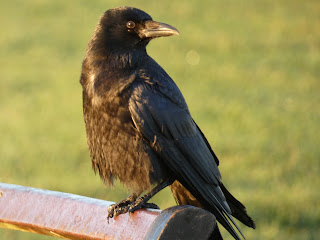This month I'm taking part in the Wildlife Trusts' 30 Days Wild challenge. The idea is to do something 'wild' every day in June. I've been sharing what I've been up to on social media a little but I thought it would be good to do a slightly more detailed summary.
Day 1: A walk around the local fishing lake led me to an encounter with a family of moorhens. Initially I just saw the adult on the footpath ahead of me but it was soon followed by three chicks. They headed into the lake and were kept undercover but I could still see them clearly.
Day 2: I was sat out in the garden in the afternoon and to my surprise a hedgehog appeared under the fence. Hedgehogs aren't normally seen out during the day and it can often be a sign they are unwell. At this time of year though breeding females will venture out in order to gather resources. This one had a long drink and ate some cat food before eventually returning under the fence and going under next door's shed where we think she might be breeding. It's likely that the really hot weather during May had made it really hard for her to find food so she was forced to try during the day.
Day 3: It rained for the first time in months and I enjoyed being outside in it with the gorgeous smell of petrichor as strong as I'd ever smelled it. The rain had kept most people indoors which meant this grey heron was very close to the bridge.
Day 4: I had one of my occasional days at work during the pandemic and ate my lunch outside by a flowerbed which had been left untended since lockdown began. In the flowerbed were loads of insects including these bugs, Aphanus rolandri which is a species which is nationally scarce in the UK. Fun fact: Linneaus, the scientist who invented the system of latin names we know use, named this species after a man called Daniel Rolander after the pair fell out over money- the name means 'Obscure Rolander'.
Day 5: After work I attempted to find a rainbow of colours in the natural world, though taking pictures proved tricky in the strong wind. Red as a poppy, orange a rusty stream, yellow a St. John's Wort flower, green a leaf, blue the sky and a thistle and stinking iris were the purpley colours.
Day 6: I spent a few minutes listening to the birds in the garden and recorded this video:
Day 7: I visited a few local places and saw lots of butterflies including these silver-studded blues. This is a heathland species which relies on ants to feed it's larvae.
Day 8: I visited Martin Down Nature Reserve near Fordingbridge, a place I'd seen online which looked really special. It more than exceeded my expectations as I saw lots of different species of butterfly including small tortoiseshell, small and common blues and a dark-green fritillary. This was because it's an excellent habitat full of wildflowers including lots of different species of orchids. I also saw some good birds too including skylarks and a red kite.
Day 9: I checked on the local swan nest and was surprised to see that only two of the four eggs remained. At the time of writing another egg has been lost and it appears the culprits are rats who are stealing easy meals.
Day 10: I went for a short walk in the New Forest before the rain came in for the day. As soon as I left the car park I could hear a cuckoo calling and after a few minutes spotted it on a telephone wire. Just as I tried to photograph it, the bird was disturbed by some walkers but it actually flew closer to me and posed on a nearby dead tree.
Day 11: It was a gloomy morning and I walked around Avon Heath Country park and despite the gloom I managed to see some sand lizards trying their best to heat up in the breeding vivarium.
Day 12: It was quite a wet day so I didn't venture far today but my wild time was spent watching some wildlife webcams, specifically those made available by Springwatch which were turned off at the end of the day. As much as I love getting close to nature, it's sometimes nice to view it from the comfort of your own home.
Day 13: We've been doing some work in the garden over lockdown and whilst we were clearing away some bushes today we discovered both a toad and a frog on the drain in our front garden. I've seen both species many times before but never so close together!
Day 14: I\planted some pollinator friendly plants in the garden and had a look at the insects that were already there. I was pleased to see loads of honey bees on the honeysuckle which had just come into flower and found this mullein moth caterpillar on the buddleia. This species will pupate underground for up to five years before it emerges as an adult moth.
Day 15: On a lovely sunny morning I walked around Stanpit Marsh in Christchurch. The wildlife I saw wasn't particularly unusual but I had some good views of birds like herons, shelducks and this reed bunting.
I will share the second half of my wild experiences at the end of the month and as I'm working a bit more I'm not sure what I can fit in so we'll have to see what I can manage!
























































